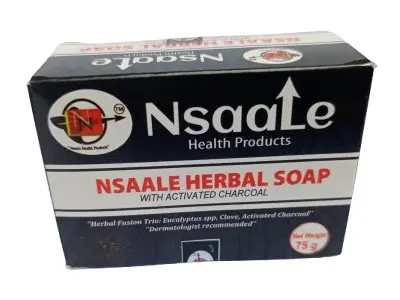Nsaale Herbal Soap with Activated Charcoal
NDA Reg. No. THA 1342
Anti-Comedones ‘’Dermatologist recommended’’
Description:
Nsaale Herbal Soap with Activated Charcoal is formulated to offer a detoxifying effect to the skin, by helping the skin to excrete toxins, excess oil, chemicals and impurities, hence helping the skin appear healthier, more youthful and invigorated due to its natural detoxifying, antioxidant, antiseptic, antimicrobial, anti-inflammatory, analgesic, antinociceptive, antibacterial and antifungal properties found in the herbal extracts blend. Crafted with the therapeutic properties of these Herbal Fusion Trio of Eucalyptus spp, Cloves and Activated Charcoal to offer a trifecta of benefits to the skin.
Active Organic Compounds:
Succinic Acid, 2,3,4,5-tetrafluorobenzyl, Tomatidine, Cyclopentasiloxane decamethyl-, Acetic Acid trifluoro-, and Salicylic acid.
Indications:
It works synergistically as a soothe and helps in relieving Bleached skin, Acne, Skin neoplasms, Dermatitis, Inflammations, Bacterial and Fungal Skin Infections.
Drug Interactions:
No adverse effects have been reported regarding the simultaneous use along with other medications. It works effectively together with Nsaale Herbal Lotion.
Dosage & Administration:
Bath the whole body 2 times a day and apply soap lather on the affected areas and leave it on until next bath.
Ideal For: All ages
Duration of Treatment:
Duration of treatment depends on the type and severity of the symptoms. Treatment should last within 4 to 24 weeks. Treatment should be maintained for 2-4 weeks after the symptoms have subsided. If symptoms persist seek medical advice.
Storage: Store below 30°C, Protect from heat and direct sunlight. Keep out of the reach of children.
Key Ingredients & Their Mechanisms of Action MoA:
- Activated Charcoal Powder: Activated charcoal possesses exceptional adsorptive properties due to its vast, porous surface area. This characteristic allows it to attract and bind to pollutants, toxins, excess oils, dirt, impurities, and bacteria from the skin's surface and pores. This physical binding action facilitates deep cleansing, helps control sebum production, prevents pore blockage, and reduces breakouts. Its ability to remove impurities contributes to skin detoxification, purification, and exfoliation by sloughing off dead skin cells, revealing cleaner skin. It also acts as a barrier against environmental pollutants, reducing free radical formation, and its detoxification properties can reduce redness and inflammation. The primary mechanism of adsorption directly contributes to the observed benefits of oil control and acne reduction. By physically removing excess sebum and impurities that clog pores, activated charcoal addresses a fundamental cause of acne and oily skin, establishing a clear link between its adsorptive capacity and its dermatological benefits.
- Succinic Acid: Succinic Acid works by supporting skin cell energy production and regeneration, helping to repair damage and promote a healthier appearance. It also acts as a mild exfoliant by loosening dead skin cells, possesses antimicrobial properties to inhibit bacterial and fungal growth, and offers anti-inflammatory benefits to soothe irritation.
- 2,3,4,5-tetrafluorobenzyl: Is included for its formulation benefits, such as acting as a stabilizer for other ingredients or as a solvent/carrier to help other active compounds disperse and potentially penetrate the skin more effectively.
- Tomatidine: Tomatidine primarily functions as an antifungal agent, effectively disrupting the cell membranes of fungi to combat infections like dermatophytes. It also contributes anti-inflammatory effects, helping to calm skin irritation and redness.
- Cyclopentasiloxane decamethyl- (D5) is a silicone that acts as a skin conditioner and emollient. It forms a lightweight, non-greasy film on the skin, enhancing smoothness, trapping moisture to prevent dryness, and providing a silky feel. It also serves as an excellent solvent and carrier for other ingredients in the formulation.
-
Acetic Acid trifluoro- is a strong acid likely used in very low concentrations for pH adjustment within the soap formulation. While potent as an exfoliant at higher concentrations, its role in a soap is typically to ensure the product's stability and efficacy by maintaining an optimal pH level, rather than significant direct skin exfoliation.
- Salicylic Acid: Salicylic acid acts as a keratolytic agent by causing the cells of the epidermis to slough off more readily, which prevents pores from clogging and allows for new cell growth. It softens and destroys the stratum corneum by increasing endogenous hydration, leading to swelling, softening, and desquamation of the horny layer of the skin. It also possesses weak antifungal and antibacterial activity. Salicylic acid's ability to promote epidermal cell sloughing directly addresses the root cause of clogged pores in acne. This exfoliation prevents the buildup of dead skin cells and sebum, thereby reducing the formation of blackheads and blemishes. Its additional weak antimicrobial activity provides a supplementary benefit against acne-causing bacteria.
